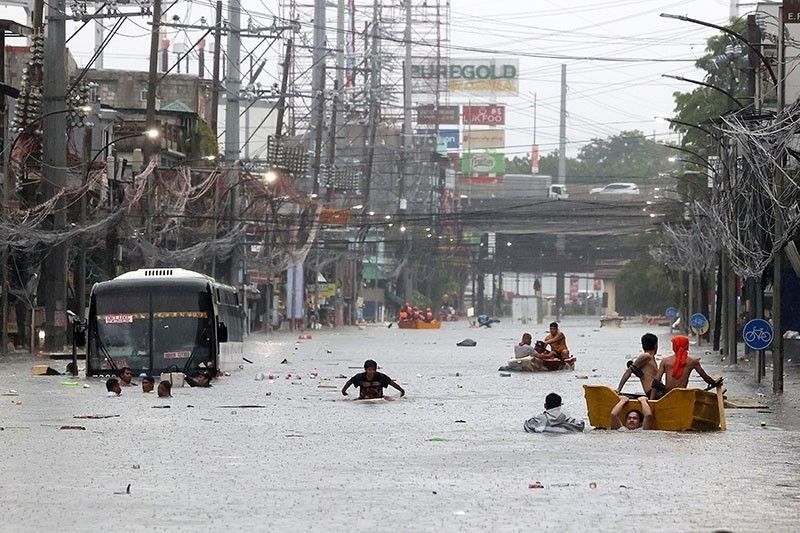Flood control

Super Typhoon Carina (international name Gaemi) put much of Metro Manila underwater after heavy rains lashed across the country due to enhanced monsoon. Reports say that within a 24-hour period, 458 mm of rain were dumped in the country’s capital city and surrounding areas, which effectively resulted in massive flooding and widespread damage to livelihoods and businesses.
The Department of Agriculture (DA) reported that as of July 30, damage to the agri-fishery sector has climbed to P1.17 billion – the total loss recorded was at 18,086 metric tons (MT), with the rice sector incurring the highest damage at P660.60 million. The number of affected farmers and fisherfolk is now at 23,580.
Carina and the monsoon’s deadly combination resulted in a death toll of 39, with the number of affected persons rising to 4.8 million, according to the National Disaster Risk Reduction and Management Council (NDRRMC). Damage to infrastructure is now at P4.26 billion, with Central Luzon again being the hardest hit with P1.6 billion worth of damage to infrastructure. There were also 2,005 houses that were either partially or totally destroyed, which amounted to P2.6 million in costs.
Government and the private sector efforts have helped ease the impact with joined efforts from across various fronts. President Marcos personally inspected the affected areas to ensure that national agencies and local government units (LGUs) were fulfilling their responsibilities effectively. Bayanihan was in full display- electricity service in the metro was monitored 24/7 despite the heavy rains, with Meralco crews proactively cutting off power in flooded areas to prioritize safety and worked swiftly to restore service as soon as the floods receded.
Several malls offered free parking, WiFi and phone charging to residents who needed shelter. Relief efforts in affected areas were immediately implemented by several private corporations.
While these efforts are commendable, Carina has raised an important question: what solutions are being implemented to end this cycle of heavy rains leading to floods and subsequent disasters, particularly in densely populated Metro Manila, home to 13 million Filipinos?
In a Palace briefing following the typhoon, Department of Public Works and Highways (DPWH) Secretary Manuel Bonoan said 70 percent of the internal drainage system in Metro Manila is blocked by garbage and silt, which caused flooding in some areas. Secretary Bonoan underscored the need to rehabilitate and upgrade the “antiquated” drainage system in Metro Manila, noting that there was running water “trapped” in the metropolis.
In the same discussion, Metro Manila Development Authority (MMDA) bared a comprehensive drainage masterplan to mitigate the flooding woes in Metro Manila. According to MMDA Chairman Romando “Don” Artes, the agency is working on the approved budget for the agency’s flood control projects amounting to P2.7 billion, of which P2.26 billion is for capital outlay and P396 million for maintenance and other operating expenses for the 71 pumping stations.
Artes said that the comprehensive drainage masterplan will be designed after the system of the Netherlands which has a 50- to 60-year drainage master plan.
The MMDA, in collaboration with the DPWH, is currently implementing the Metro Manila Flood Management Project, which involves the rehabilitation of existing pumping stations and construction of new ones.
Under the MMFMP, six of 26 pumping stations were rehabilitated and four new pumping stations will be constructed by DPWH and will be turned over to MMDA for operations.
Artes also blamed garbage for the widespread flooding in the metropolis, as well as the lack of discipline among residents, particularly those living near waterways, in disposing of their trash. The MMDA chief attributed the massive flooding in NCR to improper waste management practices that affect waterways and clog the drainage system. The presence of informal settlements disposing of waste and debris along rivers and water channels also contributes to the accumulation of obstacles that disrupt the natural flow of water.
“We regularly conduct declogging and desilting of drainage laterals, and dredging of waterways. However, we can only do so much. The problem of flooding must be addressed, not just through the government’s flood management projects, but also through the discipline of the public in their respective waste management efforts,” Artes stressed.
The MMDA has installed trash traps in various strategic locations to capture voluminous solid wastes in waterways leading to pumping stations. Additionally, the MMDA has initiated community-based solid waste management programs that include strategies targeting changes in people’s behaviors and practices in solid waste management introduced to various barangays.
Addressing Metro Manila’s perennial flooding problem requires a multifaceted approach that includes upgrading infrastructure, improving waste management practices, and fostering community cooperation.
Only through sustained and collective efforts can we hope to mitigate the devastating impacts of future typhoons and heavy monsoon rains.
- Latest
- Trending





























